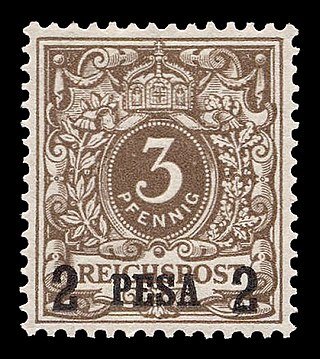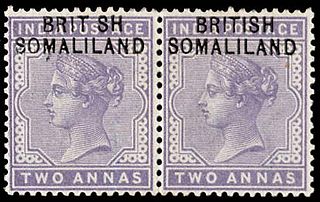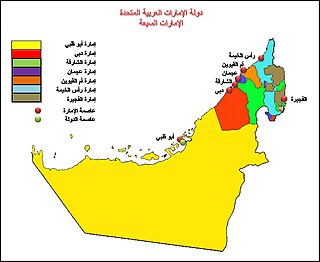
This is a survey of the postage stamps and postal history of Kuwait .

This is a survey of the postage stamps and postal history of Kuwait .
The postal history of Kuwait begins around 1775, when the East India Company began an overland desert camel service from the head of the Persian Gulf to Aleppo and Constantinople as an alternative to slower sea travel around the Arabian Peninsula. This service operated until 1795.[ citation needed ]



After the treaty with the British in 1899, the consul's office handled mail, using stamps sent from Bushire, and forwarding mail to Bushire or putting it on passing ships. The first dedicated post office opened on 21 January 1915, [1] and used stamps of India. From 1 August 1921 to April 1941 the office was administered from nearby Basra in Iraq. From 1 April 1923, Indian stamp were issued with "KUWAIT" overprints; this practice continued for many years. [2]
In 1941 the post office was temporarily closed for about a month because of the Anglo-French invasion of Iraq (during which time mail was carried by diplomatic bag through London), then re-opened under Indian administration. Owing to wartime exigencies, the office used un-overprinted Indian stamps until 1945, when a new set of Indian stamps was overprinted. This phase came to an end with Indian independence; Kuwait was administered by Pakistan in 1947 and 1948, then by the British government directly from 1 April 1948. [3]
Under British administration, British stamps were overprinted with values in annas and rupees. Unusually, the overprint was applied to all British stamps issued during this period, both regular and commemorative issues.
In 1957, the currency was decimalised, 100 naye paise (np) to a rupee, which necessitated a fresh set of overprints. These were to be the last stamps issued by the British.
In anticipation of their coming independence, the Kuwaitis took over postal administration on 31 January 1959. A first set of Kuwaiti stamps had already gone into production, with 5np and 10np values depicting Sheik 'Abd Allah III al-Salim al-Sabah, and a 40np value showing a dhow, being used on local mail in 1958. The full set of 13 values went on sale 1 February 1959, and included additional scenes of oil-related activities.

As part of independence in 1961, the government established the Kuwaiti dinar as its currency and reissued the 1959 stamps in the new values, also adding some new designs, for a total of 18 values, ranging from 1 fils to 3 dinars.
Subsequently, Kuwaiti stamp issues followed a pattern typical of many Arab countries, with designs tending to incorporate a fair amount of text, in both English and Arabic. The usual inscription reads "STATE OF KUWAIT". Definitive series included a natural-color portrait framed in silver in 1964, a portrait of Sheik Sabah in 1969, and a 32-stamp series in 1977 depicting popular games.
Kuwaiti issues came to an abrupt end with the 1990 invasion by Iraq. Iraqi stamps were used in the country until early 1991, at which point the regular Kuwaiti stamp program resumed.

Indian postal systems for efficient military and governmental communications had developed long before the arrival of Europeans. When the Portuguese, Dutch, French, Danish and British conquered the Marathas who had already defeated the Mughals, their postal systems existed alongside those of many somewhat independent states. The British East India Company gradually annexed the other powers on the sub-continent and brought into existence a British administrative system over most of modern-day India, with a need to establish and maintain both official and commercial mail systems.
This is a survey of the postage stamps and postal history of Iraq. It includes special uses under the Ottoman Empire as well as occupation issues.

This is a survey of the postage stamps and postal history of German East Africa.
This is a survey of the postage stamps and postal history of British East Africa.

Originally mail from British Somaliland used postage stamps of Egypt, then India. In 1903, about 30 types of stamps of India were overprinted "BRITISH / SOMALILAND".
The Straits Settlements of the Malayan Peninsula have a postal history distinct from the other Malayan areas.
Each "article" in this category is in fact a collection of entries about several stamp issuers, presented in alphabetical order. The entries themselves are formulated on the micro model and so provide summary information about all known issuers.
Each "article" in this category is in fact a collection of entries about several stamp issuers, presented in alphabetical order. The entries themselves are formulated on the micro model and so provide summary information about all known issuers.
Each "article" in this category is a collection of entries about several stamp issuers, presented in alphabetical order. The entries themselves are formulated on the micro model and so provide summary information about all known issuers.
Each "article" in this category is a collection of entries about several stamp issuers, presented in alphabetical order. The entries are formulated on the micro model and so provide summary information about all known issuers.
Each "article" in this category is a collection of entries about several stamp issuers, presented in alphabetical order. The entries are formulated on the micro model and so provide summary information about all known issuers.
Each "article" in this category is in fact a collection of entries about several stamp issuers, presented in alphabetical order. The entries themselves are formulated on the micro model and so provide summary information about all known issuers.
Each "article" in this category is a collection of entries about several stamp issuers, presented in alphabetical order. The entries are formulated on the micro model and so provide summary information about all known issuers.
Each "article" in this category is a collection of entries about several stamp issuers, presented in alphabetical order. The entries are formulated on the micro model and so provide summary information about all known issuers.

Now part of the United Arab Emirates, Abu Dhabi was formerly the largest of the seven sheikdoms which made up the Trucial States on the Pirate Coast of eastern Arabia between Oman and Qatar. The Trucial States as a whole had an area of some 32,000 square miles of which Abu Dhabi alone had 26,000. The capital was the town of Abu Dhabi which is on an offshore island and was first settled in 1761.
Bangladesh first issued its own postage stamps upon gaining independence in 1971. A set of eight stamps, with various motifs including a map of the country, were issued. Shortly after, stamps in eight values were overprinted "Bangladesh Liberated" in both English and Bengali were prepared in the United Kingdom, but only three values were issued in Bangladesh.

Bahrain first used the postage stamps of British India before eventually issuing its own stamps in 1960.
Qatar was a British protectorate from 1916 till it gained independence on 3 September 1971. Until 1950, the country's postal service was administered by an Indian post office in Bahrain. A British office was opened in Doha and sold stamps of British Postal Agencies in Eastern Arabia until 1957 when overprinted British stamps were introduced. Qatar Post took responsibility for postal administration in May 1963 and joined the Universal Postal Union in January 1969. The first Qatari stamps were issued in 1961 and there was an independence issue in January 1972. Since then, Qatar Post has continued to manage the country's postal administration and to issue its stamps, which are mostly relevant to Qatar itself.

The United Arab Emirates, formerly known as Trucial States, first issued revenue stamps in 1948 and continues to do so to this day. In addition, the emirates of Abu Dhabi and Dubai also had their own separate revenue issues.

British postal agencies in Eastern Arabia issued early postage stamps used in each of Abu Dhabi, Bahrain, Dubai, Kuwait, Muscat and Qatar. Muscat and Dubai relied on Indian postal administration until 1 April 1948 when, following the Partition of India, British agencies were established there. Two agencies were opened in Qatar: at Doha and Umm Said. In Abu Dhabi, an agency was opened on Das Island in December 1960 and in Abu Dhabi City on 30 March 1963. The agencies also supplied stamps to Bahrain until 1960; and to Kuwait during shortages in 1951–53.